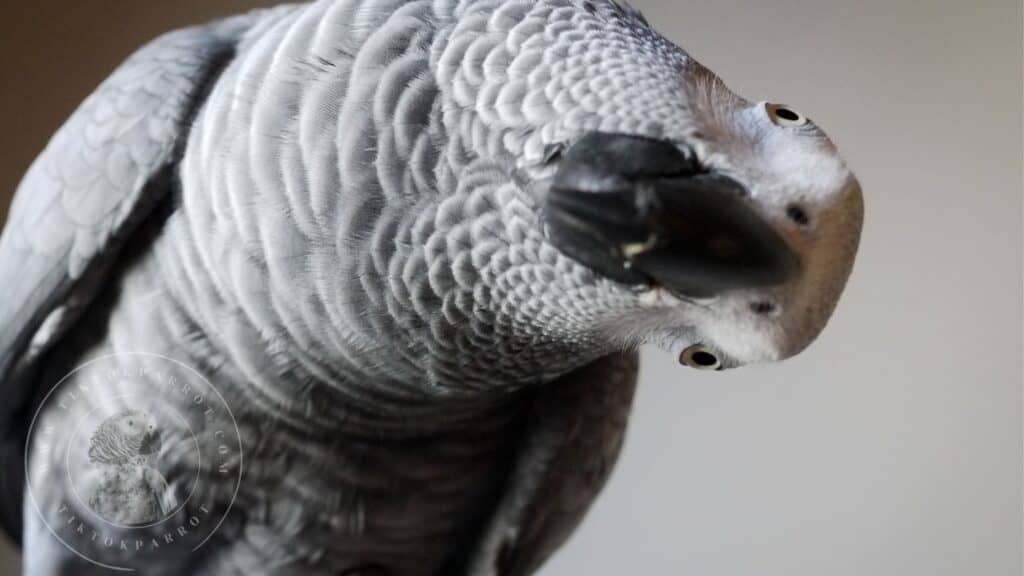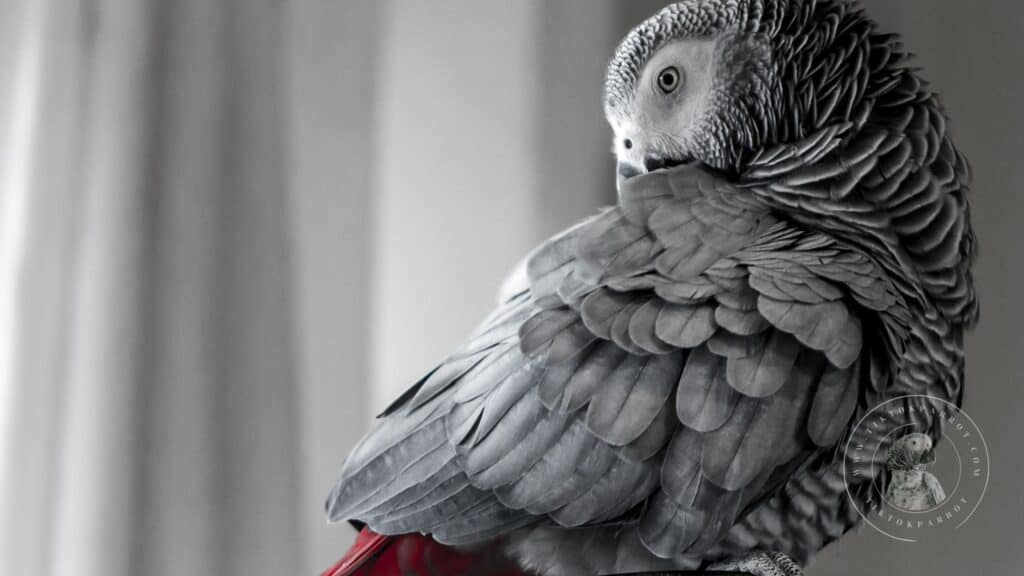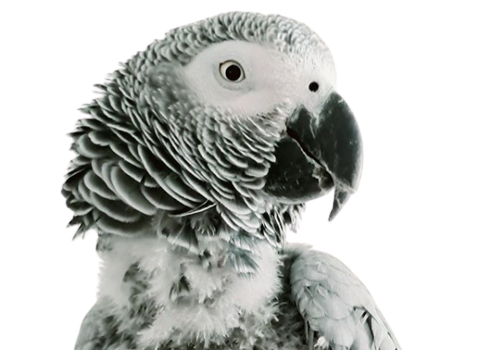Ah, African Greys. Those intelligent, sassy, and undeniably gorgeous parrots that have graced our homes (and occasionally our shoulders) for centuries. But have you ever stopped to admire the sleekness and vibrancy of their head feathers?
Discover funny habits, secret techniques & why they take such good care of their sleek silver crown. Learn how to keep your Grey’s feathers healthy & beautiful!
Unlike their flamboyant body plumage, the head feathers are a marvel of minimalism, often a sleek charcoal or a cool silver. But how do they maintain such a neat and tidy appearance? Well, as usual I would say grab your coffee, fellow parrot parents, because we’re about to delve into the fascinating, mysterious – and sometimes hilarious – and uncover the secret grooming habits of their head feathers.
Preening: It’s More Than Just Scratching an Itch

Let’s start by debunking a common misconception: African Grey parrots are not just masters of mimicry and brainy conversation; they’re also meticulous groomers, especially when it comes to their head feathers. These fine, delicate plumes play a crucial role in both their physical appearance and social interactions, so it’s no wonder they take their grooming seriously.
Now, you might be wondering, what exactly goes into maintaining those impeccably sleek head feathers? Well, for starters, African Greys are notorious preeners. They spend hours meticulously arranging each feather, using their beaks like precision instruments to smooth out any unruly strands and remove any dirt or debris that might have accumulated throughout the day.
We’ve all seen our feathered friends preen. They contort themselves into impossible positions, nibble at their wings, and flick feathers this way and that. But preening is more than just a casual itch-scratching session. It’s a vital part of an African Grey’s hygiene and overall well-being. Their feathers, like our hair, require regular maintenance to stay healthy and functional. Preening helps to:
- Remove dirt and debris: Think of it like a tiny feather bath. Preening helps remove dust, pollen, and other unwanted hitchhikers that can irritate the skin and damage the feathers.
- Spread natural oils: African Greys have a special gland near their tail that produces preen oil. This oil is spread through the feathers during preening, waterproofing them and keeping them flexible. Think of it like a natural hair conditioner for parrots!
- Detect and remove parasites: Those pesky feather mites and lice don’t stand a chance against a vigilant preening session. By meticulously going through each feather, African Greys can identify and remove these unwanted guests.
Why the Head Feathers Get Special Treatment?
Now, let’s get down to the real nitty-gritty: the head feathers. Unlike the body feathers, which they can easily reach with their beaks and feet, the head feathers require a bit more ingenuity. Here’s where things get interesting:
- The Foot Shuffle: This is a classic move. African Greys will often use one foot to gently scratch behind their head, maneuvering it with surprising dexterity to reach every nook and cranny. It’s almost like they’re giving themselves a feathery scalp massage!
- The Beak Flip: This maneuver is a bit more acrobatic. The African Grey will hold a feather in its beak and use it to meticulously groom the feathers around its head. It’s like using a tiny feather comb – talk about resourceful!
- The Body Contortion: Sometimes, if all else fails, an African Grey will resort to some impressive yoga moves. They’ll twist their head and neck into seemingly impossible positions to reach those stubborn head feathers. Let’s just say they put some contortionists to shame!
When Serious Business Gets Silly

Of course, with African Greys, there’s always a chance things will take a turn for the hilarious. Here are some of the funny preening quirks you might observe:
- The Preening Party: Sometimes, African Greys like to get social during preening. They might try to preen your hair, your clothes, or even the furniture! It’s their way of showing affection (or maybe just checking for hidden snacks).
- The One-Legged Hop: For some reason, some African Greys like to hop on one leg while they preen. It might look a bit silly, but hey, whatever works!
- The Mirror, Mirror on the Wall: African Greys are known for their intelligence, and sometimes that manifests in their preening habits. They might use a mirror to inspect their head feathers from every angle, ensuring they’ve achieved maximum sleekness.
Why does my parrot preen so much?
Some of my readers might think why their parrot preen so much, I thought I would include this question as well in my this guide. There are a couple reasons why your parrot might be preening excessively. Normally, preening is a healthy and essential behavior for birds. It helps them:
- Maintain clean feathers: Preening removes dirt, dust, and parasites that can irritate the skin and damage feathers.
- Spread natural oils: These oils waterproof and keep feathers flexible, similar to how hair conditioner works for us!
- Stay healthy: Regular preening is a sign of a happy and well-adjusted bird.
However, if your parrot seems to be preening constantly, it could be a sign of an underlying issue. Here are some possibilities:
- Boredom: Parrots are intelligent creatures and need mental stimulation. If they’re bored, they might preen excessively as a way to occupy themselves.
- Stress: Changes in their environment, lack of interaction, or loud noises can all stress out a parrot, leading to increased preening.
- Skin irritation: Dry skin, allergies, or even mites can cause discomfort that your parrot tries to soothe by preening more.
- Dietary deficiencies: A lack of certain vitamins or minerals can affect feather health and make a parrot preen more frequently.
Here’s what you can do:
- Observe your parrot’s behavior: Is there anything specific that seems to trigger the excessive preening?
- Enrich their environment: Provide them with toys, foraging opportunities, and interaction to keep them mentally stimulated.
- Check their diet: Make sure they’re getting a balanced diet with all the necessary vitamins and minerals.
- Schedule a vet visit: If you’re concerned about your parrot’s health or the preening doesn’t seem to stop, a vet can rule out any underlying medical issues.
African grey plucking or preening?

Sometimes, specially new grey owner can not tell or does not see the difference in plucking or preening. Here’s how to tell the difference between preening and feather plucking in your African Grey:
Preening:
- Normal behavior: Healthy African Greys preen regularly to clean their feathers, spread natural oils, and check for parasites.
- Appearance: Preening looks gentle. They might nibble at their feathers, fluff them up, and use their beak or foot to scratch specific areas. You might see some loose feathers, but not bald patches.
- Body language: A preening African Grey is usually relaxed and content.
Feather Plucking:
- Destructive behavior: Feather plucking is excessive and often destructive. They might bite down hard on feathers, leading to bald patches and damaged skin.
- Signs of distress: Feather plucking can be a sign of stress, boredom, anxiety, or even medical problems. You might also see pacing, aggression, or unusual vocalizations.
- Urgency: Feather plucking often looks frantic and focused. They might pluck feathers from specific areas relentlessly.
Here’s what to do:
- Observe closely: If you’re unsure, watch your African Grey’s preening behavior. Are they calm and gentle, or do they seem stressed and focused on damaging their feathers?
- Consider their environment: Have there been any recent changes that might be causing stress? Are they getting enough mental stimulation and interaction?
- Schedule a vet visit: A vet can help rule out any medical conditions that might be causing the plucking. They can also offer advice on enrichment and stress reduction techniques.
Remember: Early intervention is key. If you suspect feather plucking, address the underlying cause as soon as possible.
The Importance of Understanding Your African Grey’s Preening

But here’s where it gets interesting: African Greys aren’t just content with grooming themselves; they also engage in a bit of social grooming with their flock mates. It’s a communal activity that strengthens bonds and fosters trust among the group. So, the next time you catch your Grey giving its buddy a quick once-over, remember, it’s not just about hygiene; it’s about building relationships.
And speaking of relationships, let’s talk about the role head feathers play in the intricate dance of courtship and mating. You see, in the wild, African Greys use their vibrant head feathers to attract potential mates. A healthy, well-groomed plumage is a sign of vitality and vigor, making it highly desirable in the dating scene. It’s like having the perfect hair day, but for birds!
Of course, grooming isn’t just about looking good; it’s also about staying healthy. By keeping their feathers clean and tidy, African Greys can prevent infections and maintain optimal insulation, crucial for regulating their body temperature in the wild. So, the next time you catch your feathered friend indulging in a grooming session, give them a little nod of appreciation for taking care of themselves.
Because preening is a natural and essential part of an African Grey’s life. By understanding their preening habits, you can ensure your feathered friend has everything they need to maintain healthy, beautiful feathers. Remember, a happy preener is a happy parrot!
My Closing Thoughts
At the end I would say the secret grooming habits of an African Grey’s head feathers are a testament to the complexity and beauty of nature. From meticulous preening to social bonding, these feathered wonders have mastered the art of self-care and community upkeep. So, the next time you gaze upon your Grey’s magnificent plumage, remember the dedication and love that goes into maintaining those mesmerizing head feathers.
If you are seeing your African Grey meticulously grooming their head feathers, appreciate the dedication and ingenuity they bring to the task. After all, maintaining a sleek, silver mane takes work!
Now let me know, do you have an African Grey? Share your funniest or most interesting preening observations in the comments below!
If you found this blog helpful, It would be great if you could share it with your family and friends who might find it useful as well.
You might like to read these as well
Why African Grey Parrots Pluck Feathers
Understanding the African Grey Molting Process And How To Help
Feathered Artists: The Aesthetics and Evolution of African Grey Parrot Plumage
The Mesmerizing feather of African Grey Parrots: A Visual Delight for Bird Lovers
Top 10 Toys to Keep Your Parrot Entertained and Engaged
For more useful content about African grey parrots, you can subscribe my site with your email to get notification upon publishing a new blog, the subscribe box you can see on the right side of this page. Also if you get an alert on your web browser while browsing my site, allow it and that will also give you an alert whenever I publish a new blog.
Stay safe and much love!




